Fat Bees – Part 3
Fat Bees – Part 3
Randy Oliver
ScientificBeekeeping.com
First Published in ABJ in November 2007
I’ve been focusing on the protein dynamics of the colony. But in order to encourage brood rearing, the colony also needs a nectar flow, or its equivalent. This brings us to the subject of the feeding of sugar syrup.
Randy Oliver
In my previous articles in the Fat Bees series I discussed the importance of vitellogenin in colony protein dynamics, and the feeding of pollen supplements. Since writing those articles, I’ve had the pleasure of spending some time with Dr. Gordon Wardell, who is the developer of the Tucson Bee Diet, MegaBee. I’ve been able to use the product a bit in the field, and would like to share my initial impressions. But first, Dr. Wardell brought an important paper to my attention (Otis, et al. 2004). The authors compared the proteins in “summer” and “winter” bees. In the winter bees, they found a great increase in the metabolically-active vitellogenin, and yet an even greater increase in another protein, tentatively identified as arylphorin.
However, the finding that most caught my attention was that the total amount of storage proteins that they measured in the bees’ bodies was not nearly enough to continue brood rearing during the winter for any amount of time. Apparently, the colony is dependent upon pollen previously stored in the combs, or upon midwinter foraging, to provide enough protein for early brood rearing. This finding makes me wonder how some of our California colonies that enter the winter without a speck of visible pollen stores are able to build up at all in early January! Perhaps that is why they forage for alder and other pollens so desperately during those cold winter days.
Perhaps fall feeding of supplement is important not only to pump the bees full of vitellogenin and other storage proteins, but also to allow them to squirrel it away in the combs above the brood nest for later use. If that is the case, we should look into which supplements store best in the combs! Alternately, January protein feeding of colonies building for almond pollination may be critical if weather or lack of pasture precludes pollen foraging at that time.
I mentioned MegaBee earlier. It is now stocked at Dadant branches. I’m not here to shill the product, but I’ve played with it, and have spent time with the sales manager in my beeyard, experimenting with mixing and using it. I’ve previewed (soon to be published) data of field trials of MegaBee compared to controls, natural pollen patties, and other proprietary products—MegaBee looks dang good! I’m also aware that beekeepers have every reason to be simultaneously excited and skeptical of any new products—it’s the “once bitten, twice shy” attitude. A number of California beekeepers are trying samples as I write this, and the developer and producer are eager to work with beekeepers in working out any problems during its introduction.
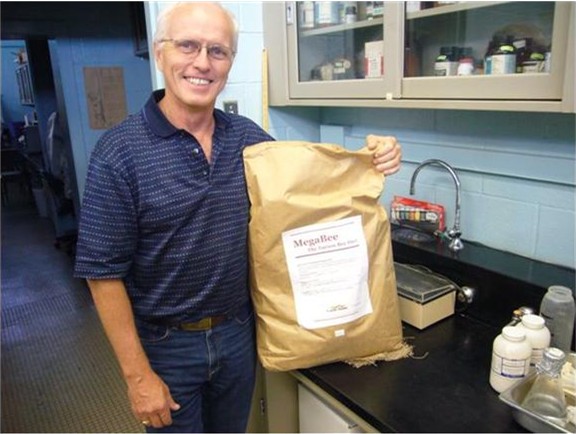
Dr Gordon Wardell in his Tucson lab. All photos by the author.
This product currently costs more than the soy-based pollen supplements, but is in the same ballpark as Feed Bee. The ingredients (as with some other products) are proprietary, but Dr. Wardell chose them based upon bee feeding preferences. Other than formulation, MegaBee is also different in that it is acidic (tastes sour), and is very finely ground for optimum digestion. So fine, that it stays in suspension in heavy syrup. Mix it in, and it just doesn’t settle. It even stays in suspension fairly well in 50:50 syrup (but not in thinner syrups).
I tried mixing with a motorized stirrer, and it blended fairly quickly. I have no idea how it will mix on a large scale. Once mixed, its preservatives keep it from spoiling, and the bees take it readily. It feeds best from an inverted feeder, and leaves little residue, except for a layer on the bottom of the container. Dr. Wardell suggests removing the lid once the feeder has been emptied, and allowing the bees to enter the feed jar to polish it clean. Unfortunately, this would require an extra trip to the beeyard. Cleanup of 1-gal feed cans may be problematic. I haven’t had the chance to feed it in a frame feeder, but Dr. Wardell indicated that it is taken quicker in an inverted feeder. Again, since the frame feeders that I use have “chimneys” to prevent bee drowning, the bees wouldn’t be able to clean the bottom anyway. This would also be a problem with top Miller type feeders.
I’ve tried various feed jars with sloped necks (see photo)—these minimized the amount of residue to that which remained on the cap.
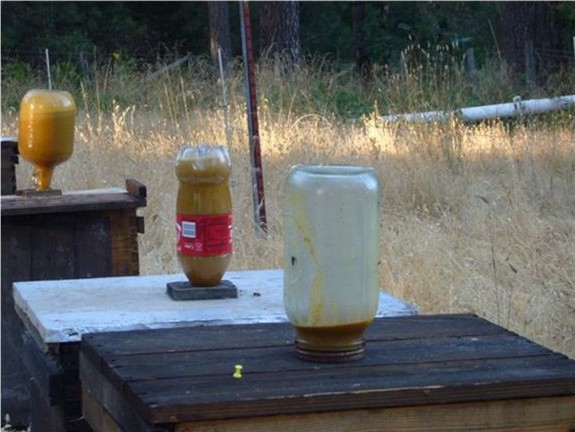
Testing various feeders for the liquid diet in one of my yards. Seeing if we can minimize residue. I’m using a hodge-podge of equipment.
When using MegaBee as a liquid feed, you avoid having to crack open the colony to insert a pollen patty. So let’s do some math: MegaBee mixes at the rate of ½ lb per gallon. Since it is 46% protein, you’d be feeding about a quarter pound of protein per gallon, along with 8.5 lbs of sugar (when using 77% syrup). With the 3-lb brewer’s yeast/sugar/pollen patties that I’ve been feeding, I give about 3/8 of a pound of protein (half as much again) with 1 pound of sugar (not counting any syrup that I feed).
If I were to feed three 3-lb patties, I’d have to feed nearly 5 gallons of MegaBee syrup to give the bees the same amount of protein. Clearly, feeding MegaBee as liquid adds substantial protein to the colony. But unless you’re really trying to add weight to the hive for winter stores, you may wish to feed at least some of the product in patty form (this also appeared to give the best results in field trials). In patty form, MegaBee mixed with heavy syrup yields nearly twice as much protein as my brewer’s yeast patty (current label instructions produce too stiff a patty—add more syrup). In my limited feeding trials, the bees ate the MegaBee patties nearly as quickly as my yeast patties with 5% natural pollen. I haven’t had the product long enough to judge the broodrearing response of the bees.
On the subject of patties, a number of beekeepers are using a top rim to allow them to feed a patty just under the lid. Generally, you want the patty to be close to the brood for good uptake, but underlid feeding appears to work for them. I haven’t tried it myself.
Several beekeepers have asked me how to tell if a colony has enough protein. I’ve already mentioned looking for foragers returning with pollen loads, and checking to see if there is pollen stored around the broodnest. When protein is superabundant, a colony will also rear drones. But when these signs are not evident, I look to make sure that the colony is rearing young brood at an appropriate level for the season, and that the young larvae are swimming in royal jelly. When the bees start cutting back on the jelly, you know that they are conserving food. Combs of newly-hatched larvae should glisten with jelly.
However, you won’t see larvae swimming in jelly unless the bees also have a nectar flow coming in, and this brings us to the subject of feeding sugar syrup. At this point, let me state emphatically, that I am not an expert by any means on feeding sugar syrup. Feeding bees is a labor-intensive, expensive pain in the rear. Many long years ago I figured out a migratory management strategy for my operation that avoided feeding of any sort whatsoever (except for cell builders when I’m rearing queens). I draw all my combs on natural honeyflows, and winter on natural honey. My large commercial friends feed more syrup some weeks than I will in my lifetime. So I’m not going to go into commercial feeding—I’ll let someone who knows what they’re talking about do that.
However, I’ll be happy to discuss the science and biology of feeding syrup, and tips for the hobbyist and sideline beekeeper. Other than specialty applications, there are three main reasons for feeding:
1. stimulation of brood rearing
2. encouraging the drawing of comb
3. putting on winter stores
The first two can be effected by feeding “light” syrup (1:1—50% sugar); the last with “heavy” syrup (2:1—67% sugar). A note is in order here: large commercial guys generally don’t have the luxury of feeding light syrup, due to spoilage and mixing issues, and because it is labor intensive for the amount of actual sugar given—but small beekeepers can use light syrup to advantage. Light syrup can be mixed in cold water, but warm water dissolves it faster (Tips: the volume increases by a factor of 1-2/3; 10 lbs of sugar added to 5 qts of water produces 2 gal of 1:1 syrup).
Be aware that light syrup can rapidly spoil during warm weather due to fermentation and colonization by yeasts, bacteria, and fungi. You can prevent this by adding unscented household bleach (“ultra” 6% sodium hypochlorite) at the rate of 1 cup per 55 gallons, or 4ml (4/5 tsp) per gallon. I’ve experimented with a bit with this chlorinated syrup. Initial free chlorine spikes quite high, then becomes undetectable to the swimming pool test strips that I used after a few hours. Yet even several hours after mixing (sealed to prevent outgassing), the syrup still prevented any microbial growth when I inoculated it. It appears that the free chlorine loosely binds to the sugar, yet retains its activity for some time. I found that as long as the syrup smelled like a swimming pool, it would sterilize any feeder that I poured it into.
A syrup preservative that I like even better than bleach is thymol. I will write about this in “The Nosema Twins 5.” You can also search this site for “thymolated syrup.”
As I mentioned above, bees need to be experiencing a nectar flow of some sort in order to stimulate broodrearing and to properly feed the larvae (with the exception that during early buildup after the winter solstice they will utilize stored honey). Even without a nectar flow, the queen may be laying eggs, but the nurse bees may just as well follow behind and eat them up! When food is short, those larvae that are reared will not be fed to the fullest, and may be capped early. During those times of nectar dearth when you want the bees to continue broodrearing uninterrupted (as in my area between fruit bloom and the main honeyflow, or in September), the feeding of light syrup will keep the broodrearing factory chugging along nicely. And the syrup can be really light! A ratio of 1 part sugar to 2 parts water (33% sugar) will stimulate a colony just fine. In fact, syrup concentrations of greater than 50% are beyond that of most natural nectars, and are not as stimulatory to the bees.
There’s an interesting aspect of bee behavior that has long been noted—colonies are hesitant to fully engage in brood rearing unless they have an adequate reserve of honey (Doolittle 1905). Bees can smell the presence of empty comb (Rinderer 1982), determine nectar flow within the colony (Seeley 1995), but we’re not sure how they sense the amount of honey stores (Seeley, pers. comm). But I’ve sure noticed that when I make up singles with drawn comb, the bees brood up more quickly if they have some combs of honey in contact with the cluster. Otherwise, they seem to hold off until they’ve put away some stores. Same with new colonies on foundation—they like to keep a reserve on either side of the brood nest. This makes perfect sense, since colonies that overextend themselves can easily starve during inclement weather. So if you’re feeding in order to stimulate broodrearing, realize that it may take a round or two of syrup before you see impressive results (and don’t forget the pollen supplement, if indicated).
During our dry California late summers, in uncrowded yards where the feeding of syrup supplements the scant natural nectar forage, I find that a half gallon of 33% syrup fed once a week keeps the colony stimulated to the point that they keep adding white wax to the combs. Looking for whitening of the comb is a very easy measure of adequate stimulation—bees only produce new wax if they sense that they have a surplus of nectar coming in. Light syrup is best fed slowly and continuously for the most stimulative effect. Feeding additional syrup is unnecessary unless you want the colony to draw comb or put on stores (but light syrup is very inefficient for adding stores). Indeed, I often see newbies overfeed their bees the first year to the extent that they create a honeybound colony, with little room for the queen to lay!

A view of the underside of the hive cover showing fresh white wax from feeding. This indicates that the bees are being stimulated adequately.
For beginners just starting colonies on foundation, I do recommend continuous feeding of light syrup until all the combs in the full brood chamber (e.g., a double deep) are drawn. This saves your new colony jillions of flight miles that would otherwise be necessary to forage for nectar, and allows them to focus on broodrearing, pollen collection, and comb building.
Feeding light syrup is great for the “morale” of the colony if there is a dearth of natural nectar. It also stimulates hygienic behavior, and thus helps with mite and disease problems. Colonies take pollen patties and medicated grease patties better when being fed (Elzen and Cox 2004). It is also useful to facilitate the acceptance of new queens. Light syrup is great during hot weather, since it cools the hive as the bees evaporate the water.
On the other hand, when you want to put on winter stores (or get colony weight up any time of the year), you want to feed as heavy a syrup as possible—first, to save you labor, and second, to make it as easy as possible for the bees to evaporate the excess water. Therefore, feed a near-saturated sugar solution. It can be made from 15 lbs of sugar dissolved per gallon of boiling water, or be purchased readymade as sucrose syrup or high fructose corn syrup (HFCS). More on HFCS later (also check the references at the end of this article, many of which are available on Beesource). Colonies can also be fed pure granulated sugar during winter—they process the crystals just fine, if the bees in the cluster can reach them! Do not feed bees any impure or unrefined sugars—they can cause poisoning or dysentery. Feed nothing but syrup made from refined (white) cane or beet granulated sugar, or clear HFCS spec’d for bee feed (Barker 1977).
So now we get to the sucrose vs. HFCS debate. Pound for pound, HFCS currently provides sugars more cheaply than sucrose (that is, in the U.S.–due to governmental price supports to both corn and sugar producers, which keep sugar prices high, and corn prices low). This price advantage is shifting somewhat as the demand for corn for the ethanol boondoggle increases. Note that I said “sugars.” Cane or beet sugar is nearly pure sucrose—a “disaccharide” (meaning “double sugar”). HFCS, on the other hand, is composed mostly of the “monosaccharides” (single sugars) glucose and fructose (roughly half and half, depending upon the type of syrup). Natural nectars are composed of various combinations of these three. Bees “invert” the sucrose in nectar into glucose and fructose when they convert nectar into honey. The point is, bees can metabolize all three sugars.
So what’s not to love about HFCS? It’s cheap, has a chemical composition similar to honey (a fact not lost upon adulterators), tends not to granulate (due to its high fructose content), and resists fermentation (due to its high osmosticity and low pH). Surprisingly, there’s been relatively limited scientific research done comparing HFCS to sucrose—see References.
Based upon the research that I’ve found, and from speaking with commercial beekeepers, bees likely prefer sucrose, build up better on it, and winter better on it. Therefore, a number of beekeepers are compromising, by asking for sucrose/HFCS blends—this way they cut costs, yet get some of the benefits of sucrose. These blends were a hot topic in California last year, when a number of beekeepers suffered colony damage from problematic HFCS blends.
**************************************
Update March 2, 2013
There has been quite a bit of additional research since I wrote this article (some as yet unpublished, much anecdotal). My take is that bees may benefit from having at least part of the sucrose in syrup being inverted into glucose and fructose (HFCS is also a source of these simple sugars). As best I can tell, colonies put on weight faster, and winter better on inverted syrup. In a recent (yet unpublished) study by Dr. Brian Johnson at U.C. Davis, package colonies on new foundation were fed either sucrose syrup or Mann Lake’s ProSweet (50:50 sucrose:HFCS). The colonies grew better on the ProSweet. Anecdotally, a number of good beekeepers who don’t have access to HFCS have told me that they get more bang for the buck by inverting sucrose syrup by heating with a bit of organic acid (citric, oxalic).
I hope to experiment with inverted sugars, and will update this page if I learn something!
Update 10 July 2017 Dr. Clarence Collison published a nice review on sugar syrups . Note that his review left out a very interesting study done in California by Dr. Brian Johnson, which indicated that colonies performed quite well when fed a commercial sucrose:HFCS blend.
Brian R Johnson, William Synk, W Cameron Jasper & Eric Müssen (2014)
Effects of high fructose corn syrup and probiotics on growth rates of newly founded honey bee
colonies, Journal of Apicultural Research, 53:1, 165-170
There was also a study with a very small number of colonies comparing comb building and colony success when fed 50% w:w sucrose or one brand of type 55 HFCS. The colonies appeared to do better on the sucrose, but I hesitate to draw conclusions, due to the small n and the design of the study.
Sammataro, D & M Weiss (2013) Comparison of Productivity of Colonies of Honey Bees, Apis mellifera, Supplemented with Sucrose or High Fructose Corn Syrup. J Insect Sci. 2013; 13: 19.
************************************************
HFCS can have problems due to other residual sugars (check the specs), and especially due to the formation of hydroxymethylfurfural (HMF). HMF forms from fructose when an acidic sugar solution is kept at a warm temperature for any length of time. The process currently used to produce HFCS from corn starch results in a decidedly acidic syrup (low pH—sometimes as acidic as vinegar!). HMF itself is clear, but a concurrent oxidation reaction caramelizes the sugars, producing a brown color. HMF does, however, have a characteristic bitter taste.
HMF is harmless to humans (and actually holds potential as a biofuel to be produced from sugar), however is toxic to bees (reviewed in Prandin, et al. 2001). It naturally forms in honey that is overheated, resulting in dark, off-flavored “bakers honey.” Such overheating appeared to be the problem last year in California—syrup blends were simply kept too hot for too long, resulting in a caramel-colored bee poison! Bottom line: look carefully at any syrup before you feed it to your bees. If it’s caramel-colored or bitter tasting, it’s not appropriate bee feed. Don’t feed your bees any syrup that you wouldn’t drink yourself!
Since I’ve mentioned the California situation, let’s do a reality check. Some California syrup blenders, sensitive to the HMF issue, are touting that they are avoiding overheating, and thus producing low-HMF syrup. I recently purchased some syrup warm and fresh from the tank of a popular supplier, and noticed that it had a faint tan color. When I questioned the blender, I was told that the batch was only a few days old, and would maintain safe HMF levels for at least two more weeks if held at 90°F. Of course, I shipped a sample off for testing—it showed an HMF titer (after a week at low temperature) of about 41 ppm. This is already at the maximum allowable concentration of HMF for European honey (although still safe for bees), but about a third of the way to frank bee toxicity. This was for fresh syrup with a very slight tint! Just in case you’re curious about the taste, let me state that I do not consider myself as any sort of corn syrup connoisseur. With that caveat in mind, in my opinion the syrup in question had a sprightly initial bite, a round, sweet body, and a pleasant fruity finish, with no trace of bitterness. Buyer beware!
So, what kind of syrup should you use? For many beekeepers, it boils down to cost and convenience. It’s a pain to mix up syrup from scratch, unless you’re already set up to do it. Heavy syrup requires boiling water. However, light syrup is much easier to mix to order (the following will only be appropriate for small-scale beekeepers). I use a 55 gal drum set upright on a stand that I forklift onto my truck. It has a propeller-type drum stirrer that fits in it. I hook a garden hose up to hot water (cold water works, just takes longer), fill the drum to an appropriate level for the sugar concentration that I want, turn on the stirrer and dump in 50-lb sacks of sugar that I get by the pallet load.
At the bottom of the drum I attached a 25-ft x 1” rubber ag hose, swivels, and a gas pump nozzle, all from Northern Tool. Even cold light syrup feeds out by gravity plenty fast with no pumping (unlike undiluted HFCS, which is so viscous that it handles best warm and pumped). I am very happy with this simple set up (I know, it’s hokey as hell, but it was cheap, and it works), but still plan to replace it one of these days with a stainless steel milk tank. Some other small beeks use modified old wringer washers—the antique machines even have hot water inlets, an agitator, and an outlet pump built in!).
So for me, it’s not much more effort to mix light syrup from granulated sugar than to mix it from a sucrose/HFCS blend. So let’s do the math with actual costs as of last week. A hundred gallons of syrup blend at 77% solids weighed in at 1132 lbs, and cost me $305 FOB the bee supply warehouse. That works out to 33.8¢ per pound for 871 pounds of sugar. If I were to purchase that much granulated sugar at 44¢/lb, the total would be $383. So I save $78 on sugar. I still need to dilute the syrup, which takes me about the same amount of labor as mixing light syrup from scratch, so I’ll call that a push. The difference is that it took me a 4-hour round trip to pick up the syrup, plus fuel and wear. The 150 miles at say, 30¢ per mile eats up $45 of that savings. That leaves $33 for my four hours of labor. Bottom line for me–I’d rather save my driving time for bee work, and mix fresh syrup from scratch as needed. For others, especially if they’re buying larger quantities, or feeding the syrup straight, the math would, of course, be different.
Once you’ve decided what type of syrup you wish to feed, you need to decide what kind of feeders to use. What is the ideal syrup feeder? Answer: there isn’t one! Every type has its advantages and disadvantages. Let’s very briefly go through the options.
1. The Boardman entrance feeder. This comes with most beginner kits. In perfect conditions they may work well, but they are rife with potential problems—too low, too near guard bees, may promote robbing, aren’t worked in cold weather, may clog with bees. I don’t recommend them.
2. The through-the-lid inverted jar top feeder. Variations are gallon feed cans, wine bottles, soda bottles, 1-gal black plastic drums, 3-gal buckets. Inverted top feeders are generally the most foolproof and easy way to feed. The syrup is given at the top of the cluster (you may have to bait the bees up through a box of foundation with a drawn comb), the lid doesn’t need to be opened, and it’s easy to check the amount fed (especially with clear jars). Downsides are that the feeders self dispense when the airspace warms, the holes may clog, they may blow off when emptied, you need to unscrew the lid to fill, there’s a hole to deal with in the hive cover, and you have one more dang piece of equipment to store.
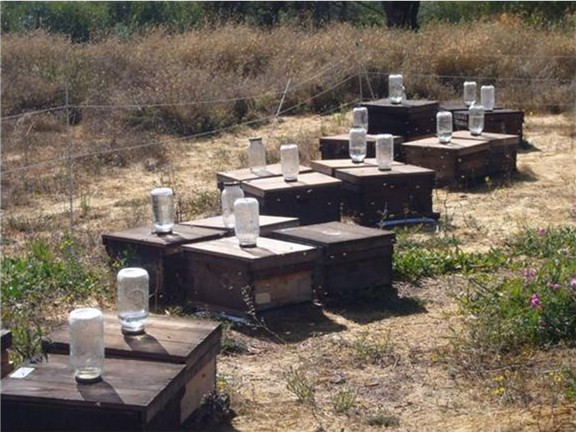
Half gallon mason jar feeders. I like the size of these for handling. Each has a 1/8” tube soldered to the lid. A 3/16” hole is drilled through the hive covers (centered for 10-frame). The bees propolize the hole when the feeder is removed.
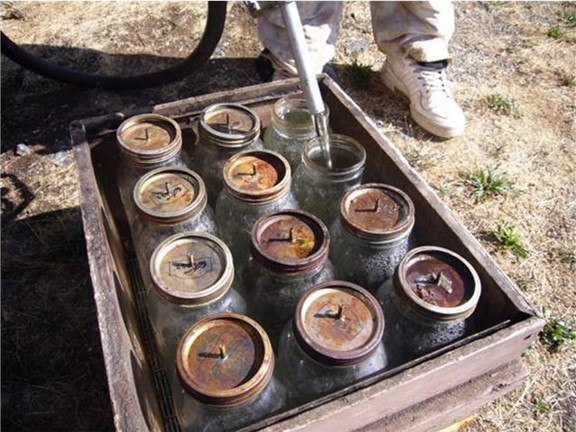
A dozen of these jars fit into a bee box nicely. A queen excluder is cleated to the bottom of the box for transport. The heavy mason jars take rough handling and don’t blow off.
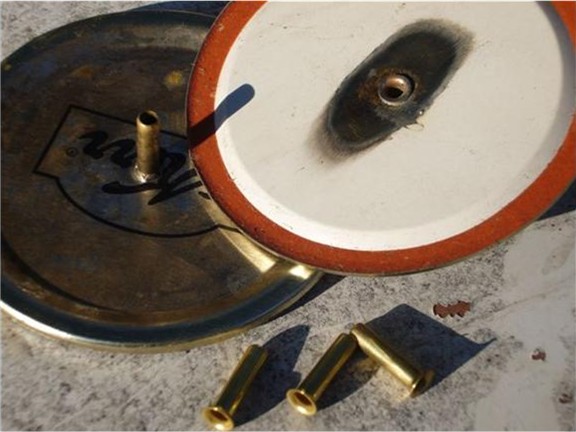
Detail of soldering of brass inserts (info on my website). These lids open easily if you occasionally grease the threads and rubber seal with Vaseline.
3. Frame feeders (also called insert, division board, or trough feeders). These can remain in the hive, but require opening the hive cover to fill, which may be a big factor in cold, rainy, or windy weather (since the propolis seal on the lid gets broken). Unless provisions are made for flotation, a lot of bees can drown during filling, especially if they’ve built comb in the feeder. A combination of drowned bees and syrup can make an ugly fermented mess, notably when rain water invariably seeps into the feeder. Then unless you notice, and pry the feeder loose to clean out the spoiled syrup and gunk, you’ll contaminate the next addition of feed. Motherlode Plastics makes a “Cadillac” feeder with a cap and perforated plastic chimneys that solve some (but not all) of the problems.
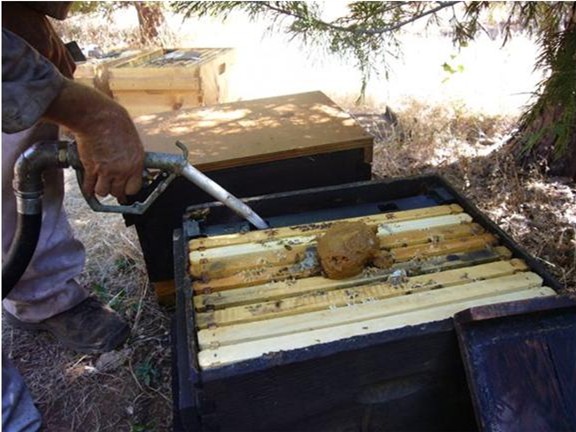
Filling a frame feeder in a split, with a chunk of pollen supplement on the top bars. For small colonies, frame feeders only work well during warm weather.
4. Miller type top feeders. These have the advantage of feeding a few gallons of syrup at a time, with minimal drownings. The black plastic inserts from Mann Lake are a great improvement over the old waxed wooden boxes. This style of feeder works well with strong colonies in warm weather, and is great for putting on winter stores. There may be problems during cool weather or rain; or if the lid doesn’t fit tightly, from robbing or ants.
5. Miscellaneous feeders: Ziplock bags with pinholes, candy boards—I’m not going to cover. Open feeding in barrels with straw on top—sometimes used by commercial beekeepers as a labor saving way to feed a yard (and any neighbors) —suffice to say that there are stress, mite, and disease issues.
Your choice of feeder depends upon the reason that you are feeding, the temperature and time of year, how far away the outyard is, how many colonies you have, how much you want to feed, your labor availability, etc. For distant outyards, a 3-gal inverted plastic bucket full of heavy syrup might be appropriate, whereas a quart of light syrup would be perfect for a nuc in the home yard. I personally use at least four different types in my own operation—depending upon the situation.
For the hobbyist, I suggest feeding with inverted quart to gallon jars (a quart a day is plenty) with a few holes punched in the center of the lid (hole size is not critical, but by using only a few small holes you help to regulate the feeding rate). Then make a simple dedicated feeder lid out of scrap wood, with a hole in the center smaller than your feeder jar lid (but larger than your hole pattern). Set your nice hive cover to the side, and temporarily use the board with the hole through it while you’re feeding. The only time that a hobbyist may have to feed when he/she is starting a colony on foundation.
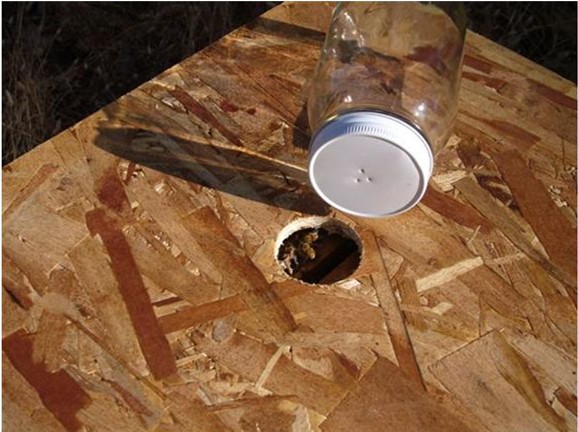
Basic feeder for the beginner. A dedicated temporary feeder lid, and a quart jar feeder.
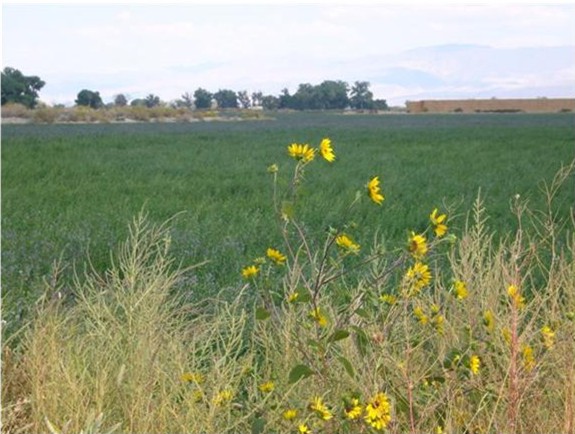
Nice natural fall forage—a field of alfalfa in bloom, sunflowers in foreground, and rabbitbrush in the background. No other feeding necessary!
References
Barker, RJ (1977) Considerations in Selecting Sugars for Feeding to Honey Bees. ABJ 117 (2): 76-77
Barker, RJ and Y Lehner (1978) Laboratory comparison of high fructose corn syrup, grape syrup, honey, and sucrose syrup as maintenance food for caged honey bees. Apidologie, 1978, 9 (2), 111-116.
Doolitte, GM (1905) A Year’s Work in an Out-Apiary republished by Wicwas Press 2005.
Elzen, PJ and R Cox (2004) Compatibility of co-application of disease control patties with supplemental syrup. ABJ 144(7): 517-518
Fischer, J (2003) The not so sweet story of sweeteners. Bee Culture 131(9):22-31.
Mussen, EC (2006) Is high fructose syrup OK? In Apiculture Newsletter Sept/Oct 2006
Otis, GW, DE Wheeler, N Buck, HR Mattila (2004) Storage proteins in winter honey bees. Apiacata 38:352-357.
Prandin, L, N Dainese, B Girardi, O Damolin, R Piro and F Mutinelli (2001) A scientific note on long-term stability of a home-made oxalic acid water sugar solution for controlling varroosis. Apidologie 32 (2001) 451-452
Rinderer, TE (1982) Volatiles from empty comb increase hoarding by the honey bee. Animal Behaviour 29:1275-1276.
Sanford, MT (2004) High Fructose Corn Syrup: A Revolution in the Making (Parts I and II ) Bee Culture 132 (5,6) http://apis.shorturl.com
Seeley, TD (1995) Regulation of comb construction in The Wisdom of the Hive Harvard University Press



